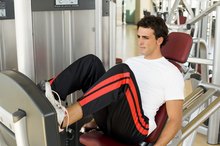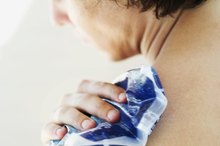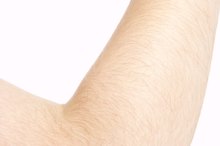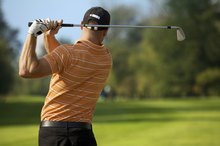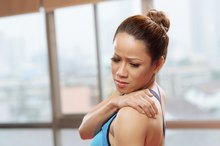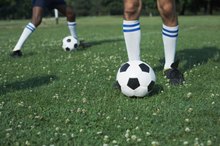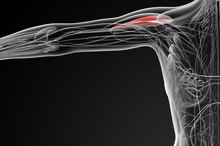Elbow Pain From Working Out
Certain exercises can cause pain and injury to your elbows during or after working out. You may use your elbows more than you realize -- any exercise that requires bending, pushing, pulling and reaching incorporates your elbow joint and surrounding muscles. If you encounter elbow pain from working out, it's important to seek out proper treatment and to learn how to prevent injuries in the future.
Causes
Elbow pain after a workout can be caused by a variety of issues, and weightlifting is a common culprit. If you overextend your elbow when lowering a dumbbell, for instance, the joint could become hyperextended and suffer injury. Allowing your posture to slacken or using overly heavy weights could also lead to pain and injury. Not warming up before doing strength-building exercises could lead to locked elbows or pulled tendons.
- Elbow pain after a workout can be caused by a variety of issues, and weightlifting is a common culprit.
- Not warming up before doing strength-building exercises could lead to locked elbows or pulled tendons.
Rest
Hurt Left Side of the Lower Back After Leg Pressing
Learn More
If your elbow hurts after working out, rest it immediately. That is, you shouldn't work out again until the joint no longer hurts. However, this can be difficult because bending and stretching your elbow is required to perform standard, daily activities. If barely moving your arm causes pain, you need to immobilize your elbow, using a sling or brace, to prevent further injury.
- If your elbow hurts after working out, rest it immediately.
- If barely moving your arm causes pain, you need to immobilize your elbow, using a sling or brace, to prevent further injury.
Treatment
Treating workout-related elbow pain can take several paths. For minor discomfort or pain, you can use an ice pack on the joint to reduce swelling and inflammation. Over-the-counter pain relievers such as ibuprofen and acetaminophen can also cut through minor pain and allow you to resume your normal life. In the cases of severe pain, you might need to see a physician. She can provide you with an accurate diagnosis and treatment path, which can include immobilizing the joint with a splint, physical therapy and surgery.
- Treating workout-related elbow pain can take several paths.
- For minor discomfort or pain, you can use an ice pack on the joint to reduce swelling and inflammation.
Prevention
Shoulder Pain After a Workout
Learn More
To prevent elbow pain in the future and further injuries, always warm up properly before every workout. One way to do this is to perform arm circles and to stretch each arm across your chest. Flexing your wrist and lightly pulling on your fingers can give your elbow a good stretch as well. Use proper form during exercise to prevent injuries. Consult a fitness professional if you aren't certain on how to do some types of exercise. You can wear elbow braces as a preventive measure.
- To prevent elbow pain in the future and further injuries, always warm up properly before every workout.
Related Articles
References
- MedlinePlus: Elbow Pain
- SimplyFit.com: Elbow Pain from Biceps Training
- Vaquero-picado A, Barco R, Antuña SA. Lateral epicondylitis of the elbow. EFORT Open Rev. 2016;1(11):391-397. doi:10.1302/2058-5241.1.000049
- Amin NH, Kumar NS, Schickendantz MS. Medial epicondylitis: evaluation and management. J Am Acad Orthop Surg. 2015;23(6):348-55. doi:10.5435/JAAOS-D-14-00145
- Blackwell JR, Hay BA, Bolt AM, Hay SM. Olecranon bursitis: a systematic overview. Shoulder Elbow. 2014;6(3):182-90. doi:10.1177/1758573214532787
- Truong J, Ashurst JV. Septic Bursitis. Treasure Island, Fl: StatPearls Publishing; 2019.
- Varacallo M, Mair SD. Proximal Biceps Tendinitis and Tendinopathy. Treasure Island, Fl: StatPearls Publishing; 2019.
- Bellapianta JM, Lavelle WF, Lavelle ED, Onyedika I, Economedes D, Whipple R. Hand Pain. Current Therapy in Pain. 2009:156-167. doi:10.1016/b978-1-4160-4836-7.00021-3
- Moradi A, Ebrahimzadeh MH, Jupiter JB. Radial Tunnel Syndrome, Diagnostic and Treatment Dilemma. Arch Bone Jt Surg. 2015;3(3):156-62.
- Saeed W, Waseem M. Elbow Fractures Overview. Treasure Island, Fl: StatPearls Publishing; 2019.
- Athwal GS. Elbow Dislocation - OrthoInfo - AAOS. OrthoInfo: American Academy of Orthopaedic Surgeons. Oct 2017.
- Bursitis. MedlinePlus. Sept 12, 2019.
- Harvard Health Publishing. The importance of stretching. Harvard Health. Sept 2013.
- Tennis Elbow (Lateral Epicondylitis) - OrthoInfo - AAOS. OrthoInfo: American Academy of Orthopaedic Surgeons. Jul 2015.
- Shah CM, Calfee RP, Gelberman RH, Goldfarb CA. Outcomes of rigid night splinting and activity modification in the treatment of cubital tunnel syndrome. J Hand Surg Am. 2013;38(6):1125-1130.e1. doi:10.1016/j.jhsa.2013.02.039
- Biceps Tendinitis - OrthoInfo - AAOS. OrthoInfo: American Academy of Orthopaedic Surgeons. Feb 2016.
- Kinaci A, Neuhaus V, Ring D. Surgical procedures of the elbow: a nationwide cross-sectional observational study in the United States. Arch Bone Jt Surg. 2015;3(1):13-8.
- American Academy of Orthopedic Surgeons. (n.d.). Elbow Arthroscopy.
- Kane SF. Evaluation of Elbow Pain in Adults. Am Fam Physician. 2014 Apr 15;89(8):649-57.
- O'Connor FG. (2018). Evaluation of elbow pain in adults. Fields KB, ed. UpToDate. Waltham, MA: UpToDate Inc.
- Sources:American Academy of Orthopedic Surgeons (n.d.). Elbow Fractures in Children.
Writer Bio
Brenda Barron is a writer, editor and researcher based in Southern California. She has worked as a writer since 2004, with work appearing in online and print publications such as BabyZone, "Cat Fancy" and "ePregnancy." She holds a Bachelor of Arts in English literature from California State University, Long Beach.
